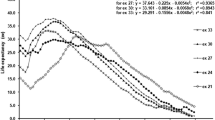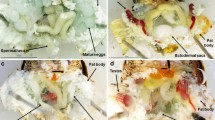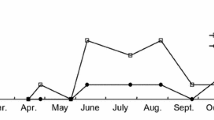Abstract
The predatory stink bug Eocanthecona furcellata (Wolff) (Hemiptera: Pentatomidae), which is widely distributed in the subtropics and tropics, is a potential biological control agent for lepidopteran, coleopteran, and hemipteran pests. We investigated development of eggs oviposited by E. furcellata females subjected to various photoperiods (i.e., 8L:16D, 12L:12D, and 16L:8D) and temperature regimes (i.e., 26:26, 30:28, 32:30, 34:32, 35:33, and 36:34 °C; temperatures at light and dark phases, respectively) at different developmental stages. Exposure of E. furcellata nymphs and adults to different photoperiods and temperature regimes affected the development of eggs they subsequently oviposited. Temperatures greater than 30 °C induced diapause in a portion of the eggs, as evidenced by the delayed appearance of the black circle and the red spot, characteristics of early and late stage of embryonic development, respectively. The proportion of diapausing eggs generally increased with increasing temperature exposure, whereas it decreased with advancing developmental stage/age at which E. furcellata was subjected to the temperature regime. Although viability of diapausing eggs was lower than that of non-diapausing eggs, diapausing eggs survived longer under high temperatures. The trade-off between survivability and viability may be a strategy to survive unpredictability of summer temperatures.

Similar content being viewed by others
References
Bell CH, Bowley CR (1980) Effect of photoperiod and temperature on diapause in a Florida strain of the tropical warehouse moth Ephestia cautella. J Insect Physiol 26:533–538
Chen K-W, Chen Y (2017) Slow-growth high-mortality: a meta-analysis for insects. Insect Sci. doi:10.1111/1744-7917.12399
Denlinger DL (2002) Regulation of diapause. Annu Rev Entomol 47:93–122
Koštál V (2006) Eco-physiological phases of insect diapause. J Insect Physiol 52:113–127
Lenin EA, Rajan SJ (2016) Biology of predatory bug Eocanthecona furcellata (Wolff) (Hemiptera: Pentatomidae) on Corcyra cephalonica Stainton. J Entomol Zool Stud 4:338–340
Lin CC, Wang HJ, Ren HD, Hong CF (1997) Studies on the biological characteristics of Cantheconidea furcellata (Wolff) (Hemiptera: Pentatomidae, Asopinae). Forest Res 11:89–93
Liu ZD, Gong PY, Wu KJ, Sun JH, Li DM (2006) A true summer diapause induced by high temperatures in the cotton bollworm, Helicoverpa armigera (Lepidoptera: Noctuidae). J Insect Physiol 52:1012–1020
Mansingh A (1971) Physiological classification of dormancies in insects. Can Entomol 103:983–1009
Masaki S (1980) Summer diapause. Annu Rev Entomol 25:1–25
Mbata GN, Phillips PW, Paytond M (2004) Mortality of eggs of stored-product insects held under vacuum: effects of pressure, temperature, and exposure time. J Econ Entomol 97:695–702
Nibouche S (1998) High temperature induced diapause in the cotton bollworm Helicoverpa armigera. Entomol Exp Appl 87:271–274
Nyunt KT (2008) Potential of the predatory pentatomid Eocanthecona furcellata (Wolff) as a biocontrol agent on American bollworm in cotton in Myanmar. PhD thesis, Georg-August University Göttingen, Germany
Pepin P (1991) Effects of temperature and size on development, mortality, and survival rates of the pelagic early life history stages of marine fish. Can J Fish Aquat Sci 48:503–518
R Core Team (2016) R: a language and environment for statistical computing. R Foundation for Statistical Computing, Vienna. https://www.R-project.org/
Ray SN, Khan MA (2011) Biology of a predatory bug, Canthecona furcellata Wolff. (Hemiptera: Pentatomidae) on poplar defoliator, Clostera fulgurita walker (Lepidoptera: Notodontidae). J Biopest 4:109–111
Rock GC (1983) Thermoperiodic effects on the regulation of larval diapause in the tufted apple budmoth (Lepidoptera: Tortricidae). Environ Entomol 12:1500–1503
Saunders DS (2012) Insect photoperiodism: seeing the light. Physiol Entomol 37:207–218
Saunders DS (2013) Insect photoperiodism: measuring the night. J Insect Physiol 59:1–10
Sinclair BJ, Vernon P, Klok CJ, Chown SL (2003) Insects at low temperatures: an ecological perspective. Trends Ecol Evol 18:257–262
Singh T, Singh PK, Sahaf KA (2013) Egg diapause and metabolic modulations during embryonic development in the silkworm, Bombyx mori L. (Lepidoptera: Bombycidae). Ann Biol Res 4:12–21
Tauber MJ, Tauber CA, Masaki S (1986) Seasonal adaptations of insects. Oxford University Press, New York, pp 38–185
Waldbauer GP (1978) Phenological adaptation and the polymodal emergence patterns of insects. In: Dingle H (ed) Evolution of insect migration and diapause. Springer, New York, pp 127–144
Wu SH, Yang D, Lai XT, Xue FS (2006) Induction and termination of prepupal summer diapause in Pseudopidorus fasciata (Lepidoptera: Zygaenidae). J Insect Physiol 52:1095–1104
Xue FS, Kallenborn HG, Wei HY (1997) Summer and winter diapause in pupae of the cabbage butterfly, Pieris melete Ménétriés. J Insect Physiol 43:701–707
Xue FS, Spieth HR, Li AQ, Hua A (2002) The role of photoperiod and temperature in determination of summer and winter diapause in the cabbage beetle, Colaphellus bowringi (Coleoptera: Chrysomelidae). J Insect Physiol 48:279–286
Yasuda T, Wakamura S (1992) Rearing of the predatory stink bug, Eocanthecona furcellata (Wolff) (Heteroptera: Pentatomidae), on frozen larvae of Spodoptera litura (Fabricius) (Lepidoptera: Noctuidae). Appl Entomol Zool 27:303–305
Acknowledgements
The authors thank Dr. Therese M. Poland (USDA Forest Service) for proofreading the manuscript. We also thank the editor of the journal and two anonymous reviewers for their valuable comments on an earlier version of the manuscript. This work was supported by funds for the Lingnan-Fruit and Grain-Oil-Crops Innovation Team, Modern Agricultural Industry Technology System of Guangdong province (2016), and Special Funds from the World Bank for Guangdong Large-scale Pollution Management Project (8311-CN).
Author information
Authors and Affiliations
Corresponding authors
Rights and permissions
About this article
Cite this article
Wen, J., Chen, KW., Fu, L. et al. Exposure of Eocanthecona furcellata (Hemiptera: Pentatomidae) nymphs and adults to high temperatures induces an aestivo-hibernal egg diapause: a strategy for surviving hot summers. Appl Entomol Zool 52, 457–467 (2017). https://doi.org/10.1007/s13355-017-0497-9
Received:
Accepted:
Published:
Issue Date:
DOI: https://doi.org/10.1007/s13355-017-0497-9




